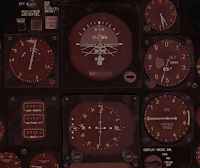This is my default forward-looking view. Lots of gadgets to see inside. Visibility out the front isn't that great. with a few aircraft structural components blocking the view. The instrument panel is somewhat disorienting, with its many old-style round dials and red instrument lighting. There are several unusual instruments and controls - things like face heat, suit heat, and spike settings - but also a lot of things that you'd see in many sophisticated aircraft.
The good news is, five of the familiar six-pack instruments are right up front and center for basic attitude flying - Airspeed, Attitude, Altitude, Heading, and Vertical Speed, are right where you'd expect to find them. I have yet to locate a turn and slip indicator, although I'd expect there to be one, somewhere. I suspect in the real aircraft, the slip ball would be in that curved tube below the primary attitude indicator, but for some reason, the author of this simulated SR-71 model didn't put it there.
I programmed this wide look-down view, so that I could see the COMM (lower left) and NAV (lower right) radios, as well as the autopilot controls (right side just forward of the NAV radio).
Full throttle also lights the afterburners for takeoff.
And we're off! As it turns out, I was immediately in over my head, because of a problem with X-Plane's "experimental flight model" that I had enabled a few months ago, while flying a different airplane, so things degenerated quickly, and I didn't catch any more pics on this series of familiarization / training flights - well, mostly crashes.
What I learned the hard way, was that with the experimental model, the SR-71 could barely get off the ground, after using all 16,000 feet of the longest runway at Denver. And even after getting off the ground, the plane was barely controllable, and couldn't climb much - it was virtually unflyable. I had to investigate online, and finally found a discussion on the X-Plane forums, where they talked about how badly the experimental flight model affects the SR-71 model. Once I turned that off, all of a sudden I could get this plane off the ground with lots of runway remaining, and it would climb well and respond quickly to the controls. It was a completely different, very fun airplane!
My next hurdle was getting the SR-71 safely back on the ground. That was an overwhelming challenge at first, because I couldn't get the plane stopped on the available runway. With the high approach speed, and no reverse thrust, the brakes weren't enough to get it stopped, before running off the end. Then I realized that this airplane has a special parachute for drag, which is typical on fast-moving military jets. I located the drag chute control on the panel, and tried it after landing, and voila, the plane easily stopped in the available runway.
With the worst lessons learned, I felt I was ready to try a cross-country trip in this plan. Next stop: Seattle Sea-Tac airport!






No comments:
Post a Comment